mirror of
https://github.com/bevyengine/bevy
synced 2024-11-26 14:40:19 +00:00
97 lines
6.4 KiB
Markdown
97 lines
6.4 KiB
Markdown
# Profiling
|
|
|
|
## Runtime Flame Graph: `tracing` spans
|
|
|
|
Bevy has built-in [tracing](https://github.com/tokio-rs/tracing) spans to make it cheap and easy to profile Bevy ECS systems, render logic, engine internals, and user app code. Enable the `trace` cargo feature to enable Bevy's built-in spans.
|
|
|
|
If you also want to include `wgpu` tracing spans when profiling, they are emitted at the `tracing` `info` level so you will need to make sure they are not filtered out by the `LogSettings` resource's `filter` member which defaults to `wgpu=error`. You can do this by setting the `RUST_LOG=info` environment variable when running your application.
|
|
|
|
You also need to select a `tracing` backend using the following cargo features:
|
|
|
|
### Backend: trace_chrome
|
|
|
|
`cargo run --release --features bevy/trace_chrome`
|
|
|
|
After running your app a `json` file in the "chrome tracing format" will be produced. You can open this file in your browser using <https://ui.perfetto.dev>. It will look something like this (make sure you expand `Process 1`):
|
|
|
|
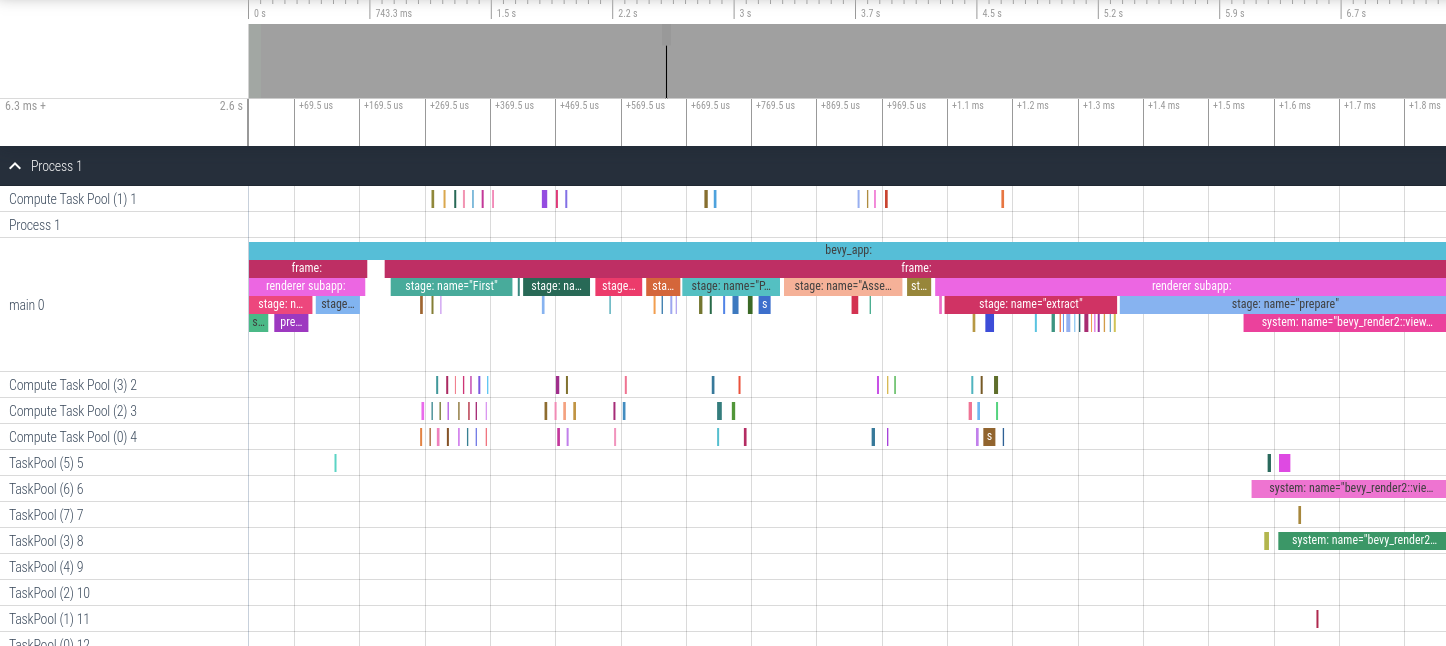
|
|
|
|
### Backend: trace_tracy
|
|
|
|
The [Tracy profiling tool](https://github.com/wolfpld/tracy) is:
|
|
> A real time, nanosecond resolution, remote telemetry, hybrid frame and sampling profiler for games and other applications.
|
|
|
|
There are binaries available for Windows, and installation / build instructions for other operating systems can be found in the [Tracy documentation PDF](https://github.com/wolfpld/tracy/releases/latest/download/tracy.pdf).
|
|
|
|
It has a command line capture tool that can record the execution of graphical applications, saving it as a profile file. Tracy has a GUI to inspect these profile files. The GUI app also supports live capture, showing you in real time the trace of your app.
|
|
|
|
In one terminal, run:
|
|
`./capture-release -o my_capture.tracy`
|
|
This will sit and wait for a tracy-instrumented application to start, and when it does, it will automatically connect and start capturing. Note that on Windows, the capture tool is called `capture.exe`.
|
|
|
|
Then run your application, enabling the `trace_tracy` feature:
|
|
`cargo run --release --features bevy/trace_tracy`
|
|
|
|
After running your app, you can open the captured profile file (`my_capture.tracy` in the example above) in the Tracy GUI application to see a timeline of the executed spans.
|
|
|
|
Alternatively, directly run the tracy GUI and then run your application, for live capture. However, beware that running the live capture on the same machine will be a competing graphical application, which may impact results. Pre-recording the profile data through the CLI tool is recommended for more accurate traces.
|
|
|
|
In any case, you'll see your trace in the GUI window:
|
|
|
|
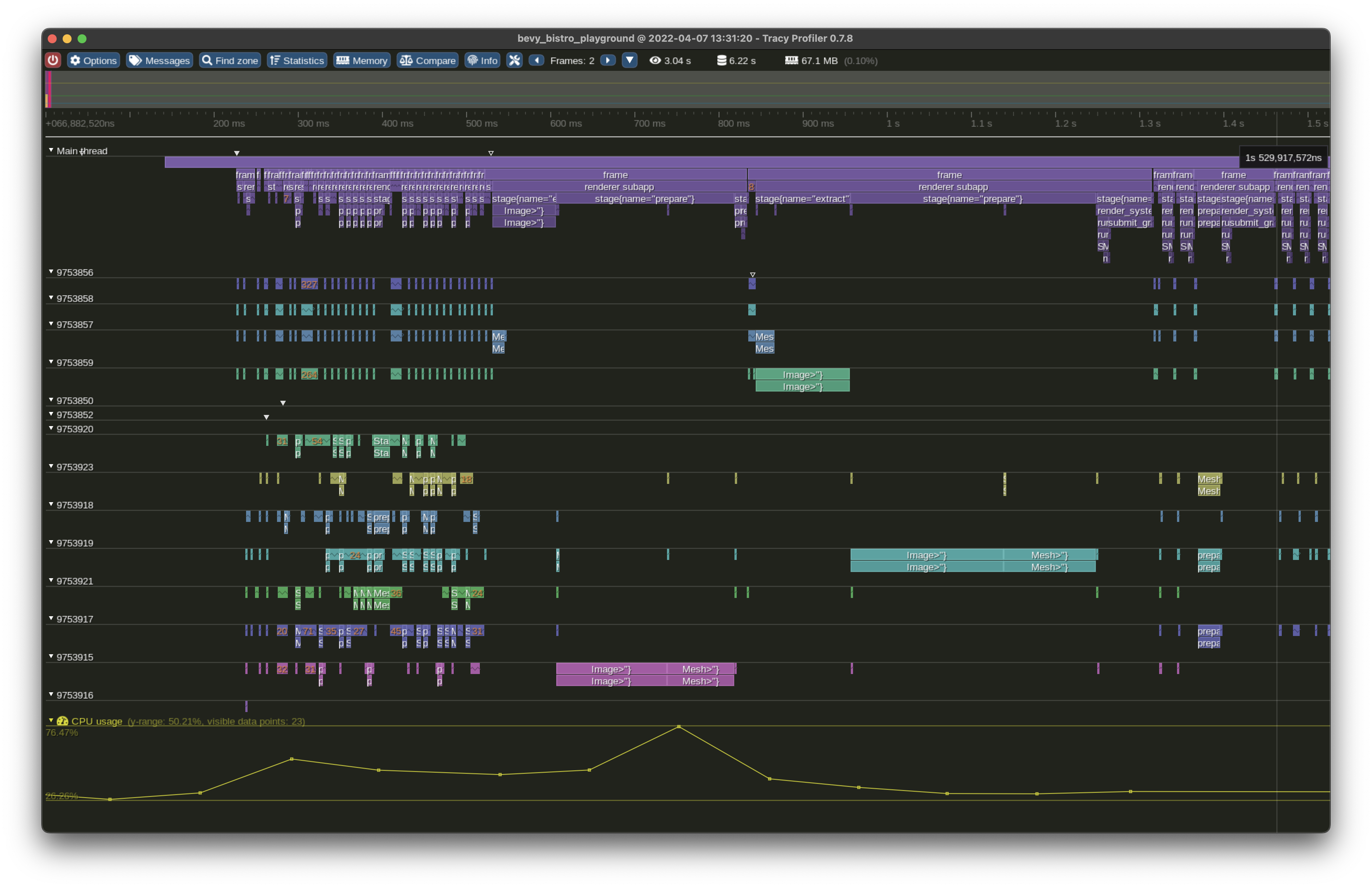
|
|
|
|
There is a button to display statistics of mean time per call (MTPC) for all systems:
|
|
|
|
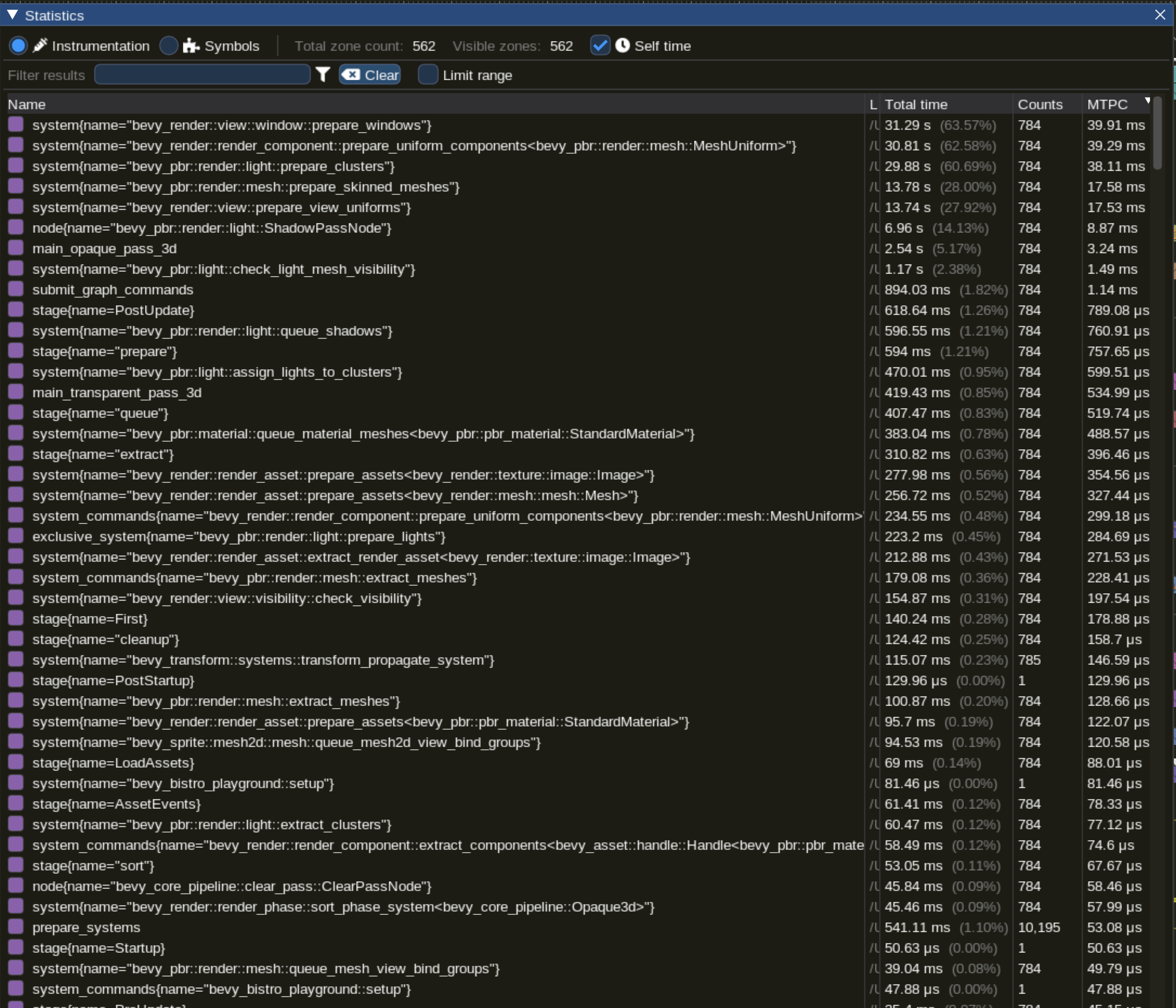
|
|
|
|
Or you can select an individual system and inspect its statistics (available through the "statistics" button in the top menu) to see things like the distribution of execution times in a graph, or statistical aggregates such as mean, median, standard deviation, etc. It will look something like this:
|
|
|
|
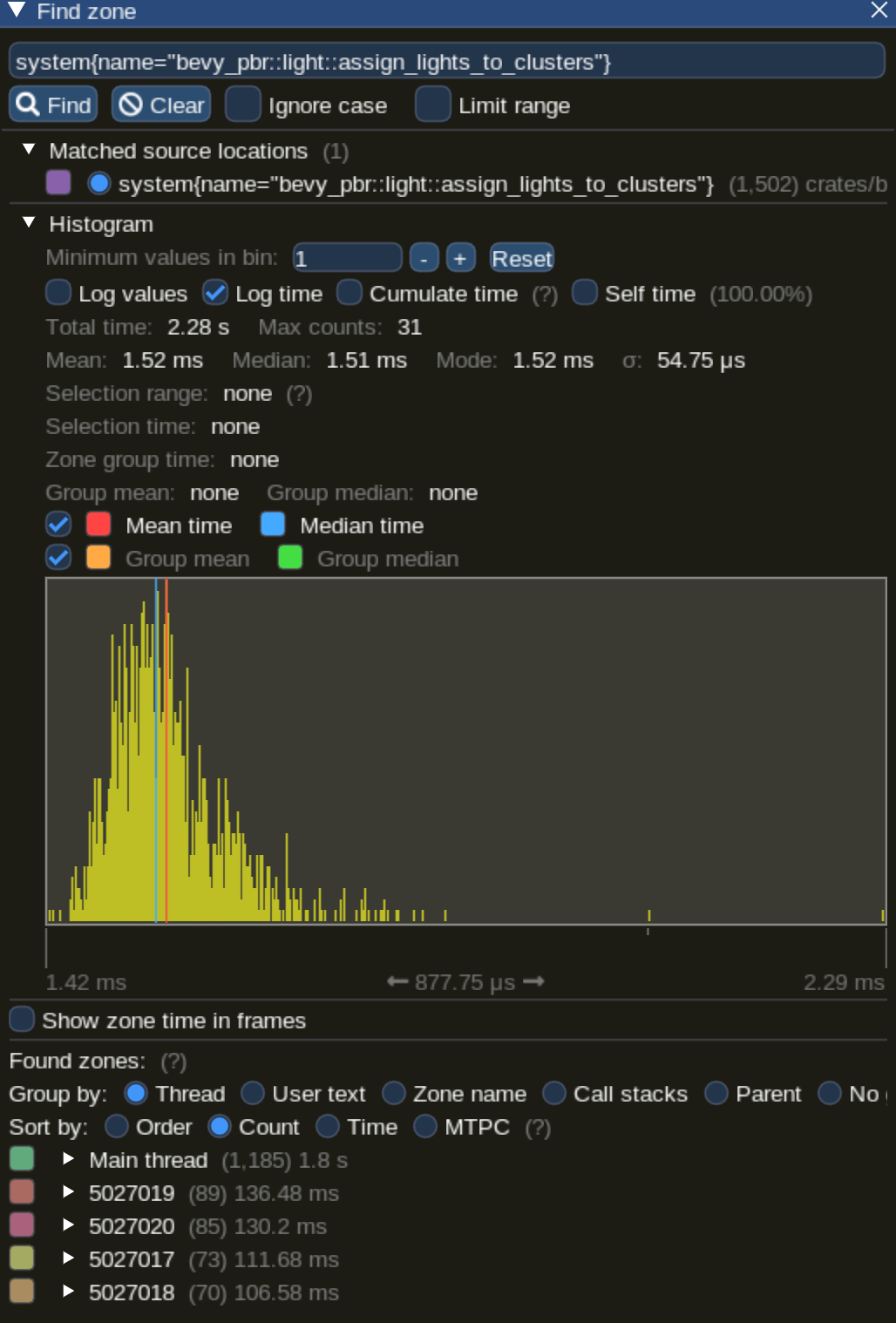
|
|
|
|
### Adding your own spans
|
|
|
|
Add spans to your app like this (these are in `bevy::prelude::*` and `bevy::log::*`, just like the normal logging macros).
|
|
|
|
```rust
|
|
{
|
|
// creates a span and starts the timer
|
|
let my_span = info_span!("span_name", name = "span_name").entered();
|
|
do_something_here();
|
|
} // my_span is dropped here ... this stops the timer
|
|
|
|
|
|
// You can also "manually" enter the span if you need more control over when the timer starts
|
|
// Prefer the previous, simpler syntax unless you need the extra control.
|
|
let my_span = info_span!("span_name", name = "span_name");
|
|
{
|
|
// starts the span's timer
|
|
let guard = my_span.enter();
|
|
do_something_here();
|
|
} // guard is dropped here ... this stops the timer
|
|
```
|
|
|
|
Search for `info_span!` in this repo for some real-world examples.
|
|
|
|
For more details, check out the [tracing span docs](https://docs.rs/tracing/*/tracing/span/index.html).
|
|
|
|
## `perf` Runtime Flame Graph
|
|
|
|
This approach requires no extra instrumentation and shows finer-grained flame graphs of actual code call trees. This is useful when you want to identify the specific function of a "hot spot". The downside is that it has higher overhead, so your app will run slower than it normally does.
|
|
|
|
Install [cargo-flamegraph](https://github.com/killercup/cargo-flamegraph), [enable debug symbols in your release build](https://github.com/killercup/cargo-flamegraph#improving-output-when-running-with---release), then run your app using one of the following commands. Note that `cargo-flamegraph` forwards arguments to cargo. You should treat the `cargo-flamegraph` command as a replacement for `cargo run --release`. The commands below include `--example EXAMPLE_NAME` to illustrate, but you can remove those arguments in favor of whatever you use to run your app:
|
|
|
|
* Graph-Like Flame Graph: `RUSTFLAGS='-C force-frame-pointers=y' cargo flamegraph -c "record -g" --example EXAMPLE_NAME`
|
|
* Flat-ish Flame Graph: `RUSTFLAGS='-C force-frame-pointers=y' cargo flamegraph --example EXAMPLE_NAME`
|
|
|
|
After closing your app, an interactive `svg` file will be produced:
|
|

|
|
|
|
## Project Compile Times
|
|
|
|
Append `--timings` to your app's cargo command (ex: `cargo build --timings`).
|
|
If you want a "full" profile, make sure you run `cargo clean` first (note: this will clear previously generated reports).
|
|
The command will tell you where it saved the report, which will be in your target directory under `cargo-timings/`.
|
|
The report is a `.html` file and can be opened and viewed in your browser.
|
|
This will show how much time each crate in your app's dependency tree took to build.
|
|
|
|
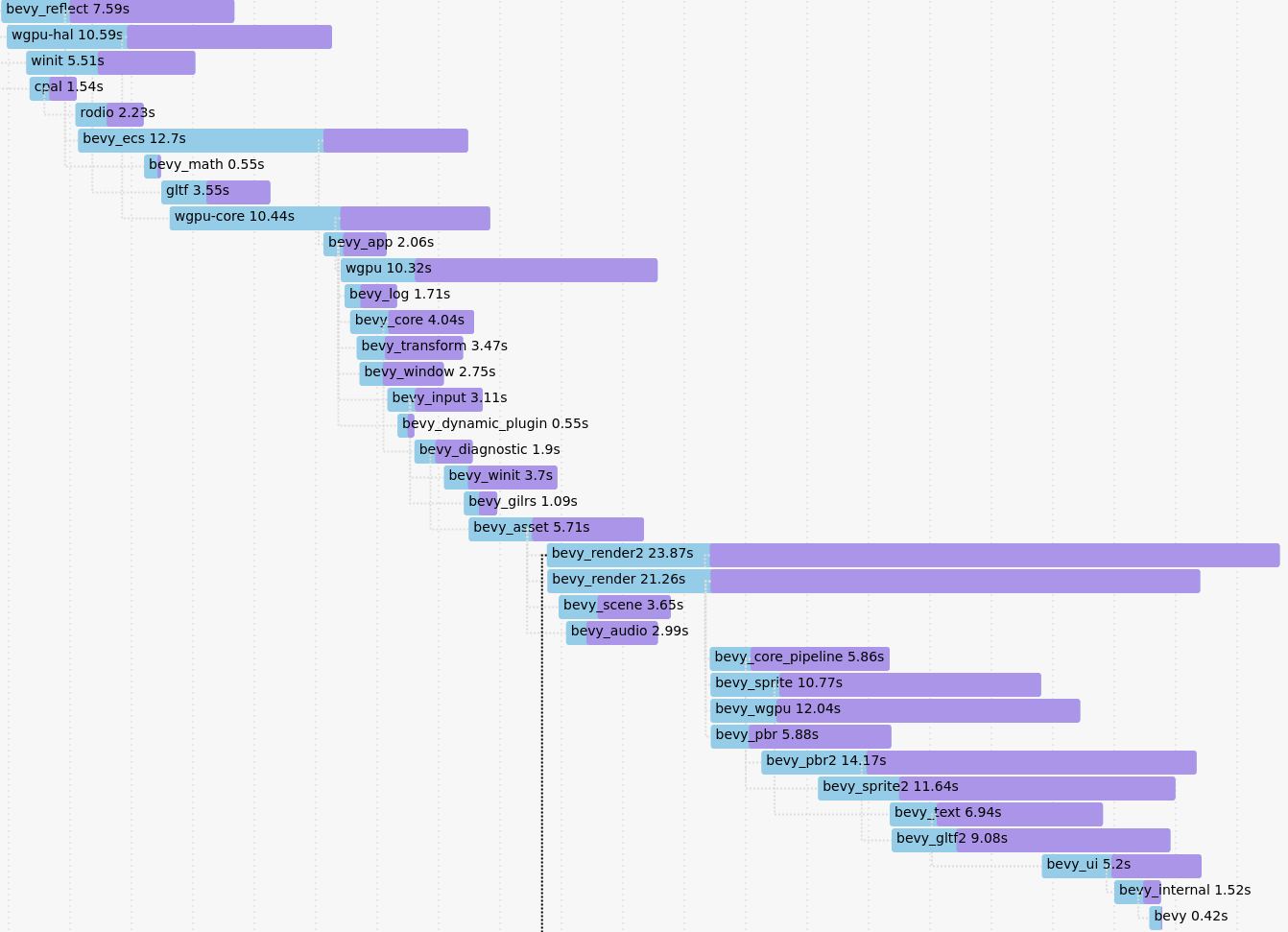
|